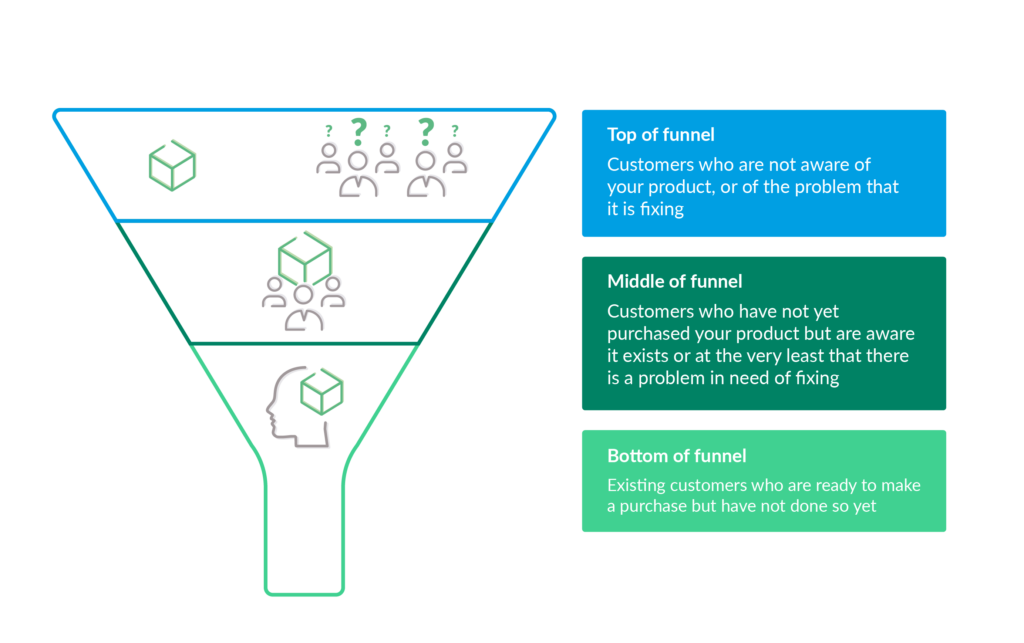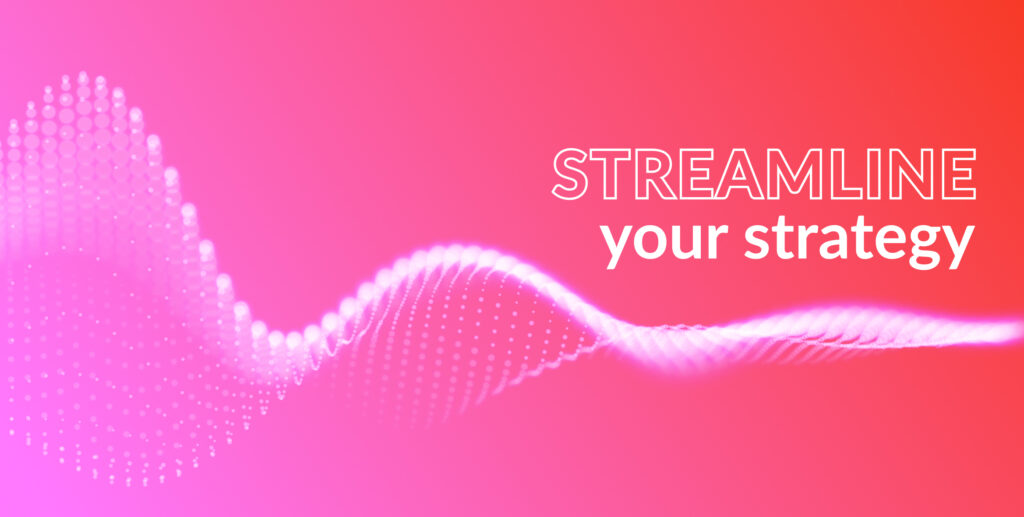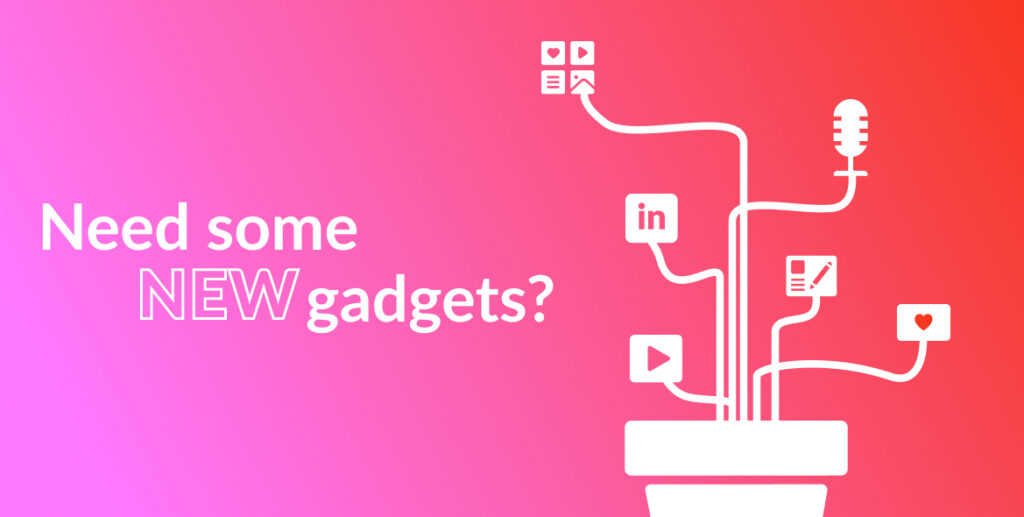To create a successful B2B marketing strategy, planning and segmentation are key. A popular (and effective) way of approaching your plan is to base it on the marketing funnel model, which goes as follows:

Once these are clear and you have defined which customers are where, you can create a strategy for each stage of the funnel, to move customers all the way to the bottom, where conversions happen.
To kick off the sales process, start with those at the top of the funnel, determining activity for relevant lead generation (meaning leads that are likely to eventually become customers). To help you get started, here are some tips on creating a successful content marketing campaign.
What is top of funnel marketing and why is it important?
Top of funnel marketing encompasses the activity aimed at people who are not yet customers. Don’t forget that the B2B customer journey tends to last longer than a B2C one, as it’s more complex and involves multiple stakeholders. Before making any type of purchasing decision, your buyer needs to understand your offer. This could mean online research, comparison sites, or discussions with colleagues and peers. This could also be country-specific, so before entering any market, you should also do detailed research. For example, if you’re entering the Malaysian market be sure to research and get Malaysia insights on the market, trends etc
It’s best to assume your audience knows nothing about your product or service. This means no aggressive sales pitching at this point – it might be counterproductive. Instead, focus on your customer’s pain points rather than your product or service – you often will not even need to mention it at all.
Remember that you are playing the long game; you will get new website traffic and leads, but the aim is to provide support, information or help to your prospects. This will position your business as a helpful ally in their mind, so you can convert them when the time is right.
You will not only start to build brand awareness, but brand loyalty too – plus, a lot of this content is long term and can be repurposed over and over. To do this effectively, remember to track and measure your campaigns, so you can create, repurpose, or chuck content accordingly.
What are the main best practices of top of funnel marketing?
It might sound obvious but you need to plan this stage of your customer’s journey. Think of when you want to show up for them and when you want them to engage with you. Setting up various conversion points can be an effective way of both capturing large volumes of potential new business and moving them along the funnel. For instance, offering downloadable content for free, which can also be used for email capturing.
However, don’t try to do too much – remember a consistent experience is crucial to achieving brand recognition (and eventually, loyalty). Be consistent even in a multichannel landscape, by sticking to the same tone, messages, slogans and so on; to help solidify your brand in customers’ minds.
How can SEO-focused content (Search Engine Optimisation) help your strategy?
When publishing written content, make sure it is created in an appropriate tone, with relevant information and the right keywords, so that your site appears at the top of Google’s results. As cliché as it sounds, put yourself in your customers’ shoes – think of what they would type into Google and adapt your site accordingly, always ensuring it includes the appropriate terms. If you are stuck or would like a more thorough analysis, there are online tools that you can use.
Keep in mind that once the lead has clicked on your content, you want them to stay and consume more of it for as long as possible (rather than quickly closing off your tab). This gives them more time to find out about the product, and it gives you an opportunity to generate interest and value from the get-go. Some effective tactics to consider are content association (e.g. “if you liked this, you will LOVE last month’s post”); free tools (e.g. “download our free expert guide”,) fear of missing out (e.g. “tickets to our event are almost sold out”); or urgency (e.g. “only 2 hours left to sign up to our webinar”).
How do you create the right social media strategy?
Similarly to what you did for SEO, wear your customer hat and have a think about what platforms the businesses you are targeting are on. When done right, a combination of organic and paid content tends to work best.
Having a social media presence is not enough anymore, you also need the right approach to succeed – in terms of tone, content and platform. Be active and post regularly. When managing multiple social media accounts, do not forget providing fresh and unique pieces of content to engage your diverse followers Spend time defining your segmentation strategy to target all the stages of the sales funnel appropriately, for which you can get our tips and a free template in our blog about creating customer profiles. Essentially, top of funnel content should be meaningful, current and aim to position you as an industry leader, or at least a knowledge expert. The key is to add value to businesses that did not know they needed you.
Where should you advertise your content online?
You will be able to run B2B advertising campaigns on many of the platforms you will use to interact with business prospects, so create a paid strategy that supports your organic activity. Think about:
- Sites and advertising opportunities e.g. is the business you’re targeting active on the platform? Does it offer segmentation, ad management, or reporting capabilities?
- Are there any databases you could leverage? e.g. An email marketing campaign could be sent to the contact list of an organisation with the same, or similar, target audience.
- Cost structure. One of the most popular ones is PPC (pay per click) as it can help you quickly scale with qualified leads at a reduced cost (when done right). PPC is available for social posts, display ads and others such as sponsorships, newsletters, or programmatic ads. A tool that can help you design display ads is Creatopy.
- Metrics. Make sure you know how to define, track and measure content, so you can optimise your strategy and ROI effectively.
Key takeaways
In a nutshell, top of funnel marketing can help you kick-off a sales cycle by putting your business in front of potential customers who are not looking for a product or service like yours:
- Segment your audience so that you can customise your content as much as possible – this will heighten the effectiveness of your message.
- Use a combination of organic and paid activity, to widen your reach.
- Remember to make SEO a key part of your strategy.
- Use social media platforms to interact with potential customers where they are.
- Finally, always measure for ongoing campaign optimisation.
And if you are thinking about outsourcing for guaranteed results, email us at hello@isolinecomms.com to find out how we can support you in your B2B tech content marketing journey.



